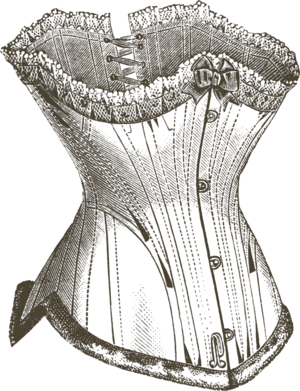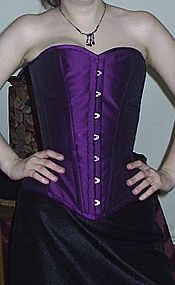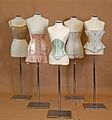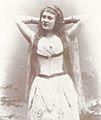Corset facts for kids

A corset is a special type of clothing worn underneath other clothes. It is designed to shape the body, usually the middle part called the torso. People wear corsets for different reasons, like for fashion or for medical help. Both men and women have worn corsets throughout history. For a long time, corsets were a very important part of women's clothing.
Today, you might see "corset" used for tops that look like old corsets. These modern tops often have lacing or stiff parts. However, they usually don't change the body's shape much. Real corsets are often custom-made by a corsetmaker to fit a person perfectly.
Contents
What Does "Corset" Mean?
The word corset comes from an old French word, corps. This word means "body." The skill of making corsets is called corsetry. Sometimes, the word corsetry is also used to mean many corsets together. A person who makes corsets is called a corsetier (for a man) or a corsetière (for a woman).
The word "corset" became common in English around 1828. It was used to describe a lighter type of body-shaping garment. This helped to tell it apart from the heavier "stays" that were worn before.
Why People Wear Corsets
Fashion and Style
The most common reason people wore corsets was to make their body fit a popular fashion shape. For women, this often meant making the waist look smaller. This would make the bust (chest) and hips look bigger, creating a curvy shape. However, at other times, corsets were used to create a straight, slim look. This meant making the bust and hips appear smaller.
Men also wore corsets, usually to make their figure look slimmer. From about 1820 to 1835, it was fashionable for men to have a very small waist. Wearing a corset sometimes helped them achieve this "wasp-waisted" look.
In the past, corsets also helped support large dresses, like the crinoline or bustle. These dresses were very wide and needed a strong base. People often wore a thin layer of clothing, like a light shirt, under the corset. This protected the skin from the corset and made the lines of the corset smoother. It also helped keep the corset clean, as corsets with metal parts were hard to wash.
Medical Reasons
Sometimes, corsets are used for medical reasons. People with back problems, like scoliosis (a curved spine), might wear a special corset. This helps to keep their torso still and protected. For example, the artist Andy Warhol wore a corset for the rest of his life after he was shot in 1968.
How Corsets Are Made
Corsets are usually made from strong, flexible materials like cloth (especially a fabric called coutil) or leather. To make them stiff, thin strips called "boning" are put into channels in the fabric. In the past, these strips were often made from baleen, which comes from whales. Today, plastic is often used for boning. Stronger, better quality corsets often use spring or spiral steel. Other materials like ivory, wood, and cane have also been used.
Corsets are held together by lacing, usually at the back. When the laces are pulled tighter, the corset becomes firmer. Depending on the fashion of the time, corsets could be laced from the top down, the bottom up, or both ways. In the Victorian era, wealthy women often had their maids tighten their corsets. Gentlemen might have their valets help them.
History of Corsets
The idea of the corset is often linked to Catherine de' Medici, who was married to King Henry II of France. In the 1550s, she made a rule that women at court should have slim waists. For almost 350 years, the corset was the main way women supported their clothes and shaped their bodies. These early corsets used laces and stiff parts made from whalebone or metal.
Images for kids
-
A drawing of a luxury hourglass corset from 1878, showing a front fastening and lacing at the back
See also
 In Spanish: Corsé para niños
In Spanish: Corsé para niños














